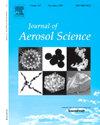火焰稳定性对 FSP 过程中氧化铁纳米粒子生长的影响
IF 3.9
3区 环境科学与生态学
Q2 ENGINEERING, CHEMICAL
引用次数: 0
摘要
由于火焰喷射热解(FSP)过程中的火焰稳定性会影响合成颗粒的属性和纯度,因此它一直是一个活跃的研究课题。本文研究的燃烧器的独特之处在于能够在新定义的稳定图上控制火焰稳定性。当前工作的新颖之处在于了解这些广泛的稳定性模式在 FSP 过程中对纳米粒子生长以及所收集产品属性的影响。为氧化铁纳米粒子合成选择了几种不同的火焰配置,从稳定火焰到高度不稳定火焰。通过 OH∗ 化学发光和宽带火焰发光成像对火焰稳定性进行了表征。稳定性与火焰发光变异系数(CV)相关,火焰高度与平均 OH∗ 化学发光相关。然后使用平面米氏散射来确定火焰发光间歇性对喷雾雾化和蒸发质量的影响。对于颗粒分析,在燃烧器出口平面上方 30 至 200 毫米处进行原位热导取样,并通过透射电子显微镜(TEM)进行分析。此外,还通过高分辨率 TEM、X 射线粉末衍射 (XRD) 和衰减全反射傅立叶变换红外光谱 (ATR-FTIR) 对收集的散装产品进行了进一步的原位分析。研究表明,与具有相同前驱体体积流量的稳定火焰相比,不稳定性较高的火焰(CVmin ≥ 0.35)可保持较高的喷射高度(26%)和较低的火焰高度(79%)。这减少了初级颗粒生长的高温颗粒停留时间,并影响了随后的团聚。例如,平均回旋直径和初级粒子直径的变化分别为 44% 和 29%,这取决于火焰制度。原位分析还表明,无论稳定性如何,产生的主要氧化铁相都是方镁石。然而,通过 ATR-FTIR 发现,随着火焰不稳定性 (CV) 的增加,包括甲基、亚甲基和羧酸官能团在内的有机杂质浓度也会增加。本文章由计算机程序翻译,如有差异,请以英文原文为准。
Influence of flame stability on iron oxide nanoparticle growth during FSP
Flame stability during flame spray pyrolysis (FSP) remains an active topic of investigation due to its impact on synthesised particle attributes and purity. The unique feature of the burner investigated here is the ability to control flame stability over newly defined stability maps. The novelty of the current work lies in understanding the influence of these broad stability modes on nanoparticle growth during FSP and on the attributes of collected products. Several distinct flame configurations are selected for iron oxide nanoparticle synthesis, ranging from stable to highly unstable flames. The flame stability regimes are characterised by OH∗ chemiluminescence and broadband flame luminescence imaging. Stability is correlated with the coefficient of variation of flame luminescence (CV) and flame height with mean OH∗ chemiluminescence. Planar Mie scattering is then used to identify the effect of flame luminescence intermittency on spray atomisation and evaporation quality. For particle analysis, in-situ thermophoretic sampling is performed from 30 to 200 mm above the burner exit plane and analysed via transmission electron microscopy (TEM). Further ex-situ analysis is also performed on the bulk-collected product via high-resolution TEM, X-ray powder diffraction (XRD), and attenuated total reflectance Fourier transform infrared spectroscopy (ATR-FTIR). It is demonstrated that flames with higher instability (CVmin ≥ 0.35) maintain increased spray heights (>26 %) and reduced flame heights (>79 %) compared to stable flames with the same precursor volume flowrate. This reduces the high-temperature particle residence time for primary particle growth and impacts subsequent agglomeration. For example, the mean diameter of gyration and primary particle diameter are found to vary by 44 % and 29 % depending on the flame regime, respectively. Ex-situ analysis also demonstrates that the dominant iron oxide phase produced is maghemite regardless of the stability regime. However, higher concentrations of organic impurities including methyl, methylene and carboxylate functional groups are found via ATR-FTIR with increased flame instability (CV).
求助全文
通过发布文献求助,成功后即可免费获取论文全文。
去求助
来源期刊

Journal of Aerosol Science
环境科学-工程:化工
CiteScore
8.80
自引率
8.90%
发文量
127
审稿时长
35 days
期刊介绍:
Founded in 1970, the Journal of Aerosol Science considers itself the prime vehicle for the publication of original work as well as reviews related to fundamental and applied aerosol research, as well as aerosol instrumentation. Its content is directed at scientists working in engineering disciplines, as well as physics, chemistry, and environmental sciences.
The editors welcome submissions of papers describing recent experimental, numerical, and theoretical research related to the following topics:
1. Fundamental Aerosol Science.
2. Applied Aerosol Science.
3. Instrumentation & Measurement Methods.
 求助内容:
求助内容: 应助结果提醒方式:
应助结果提醒方式:


